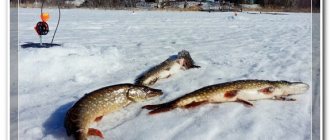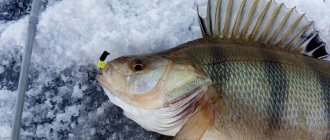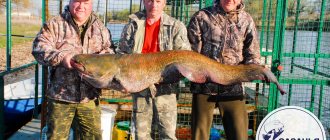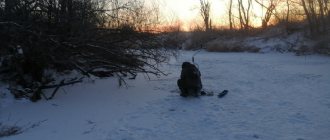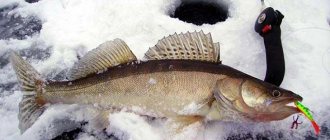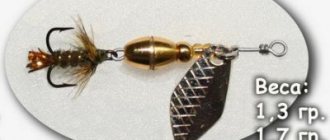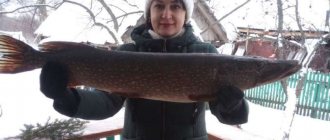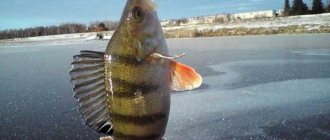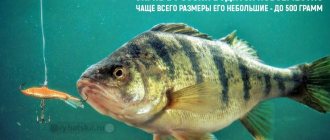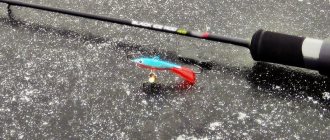Yuri 12/15/2020 170
Perch hunting is popular among fishermen. There are many techniques for successfully catching a predator. Often anglers, especially beginners, are interested in whether perch bites on a worm? Fish are famous for their gluttony, so there will be no problems. The predator readily bites on this bait. This method does not require experience or training. It is important to choose the right gear, and of course know the “fishing” places.
Features of the bait
Catching perch with a worm is one of the most undemanding methods. It is popular with both beginners and experienced fishermen. You can buy a live worm at any fishing store. But store-bought worms do not have a specific “natural” smell that attracts fish. Therefore, many fishermen prefer to prepare them themselves, although this is not the most pleasant experience.
There is also an alternative to live food - silicone worms. They are treated with flavorings that drive the predator crazy. In stores you can find worms of different sizes and shades. The most successful colors are black, brown and red.
It is also important to choose the right tackle for catching perch with a worm. Many people, out of habit, prefer spinning - you can cast it far from the shore, as well as fish from a boat at depth. But a regular float rod is more suitable. Perch is not large in size, so a light float weighing up to 1 g is enough.
Baits for winter fishing
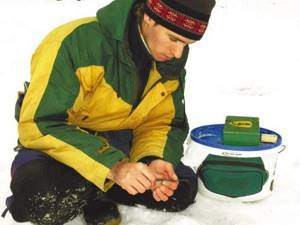
Photo by the author
Usually, most winter fishing enthusiasts limit themselves to bloodworms. It is certainly good as a bait, but there are reservoirs whose features allow you to successfully fish with other baits. You should especially experiment more with different baits on rivers, oxbow lakes and channels, as well as during prolonged thaws, when insects reviving in the sun fall under the snow with the flow of melt water.
Usually, large bloodworms are purchased for bait. However, during a capricious bite, several larvae of food bloodworms, put on a hook in a bunch, often help out. Large, cautious fish like this bait: bream, roach, perch.
In winter, bloodworms are obtained through an ice hole on the muddy bottom, for which a special scoop with a long handle is used. The dirt removed from the bottom is washed in a large sieve and the larvae are selected. Hooks with a thin sting are suitable for baiting large bloodworms. There are several ways to make money. The most common one is under a dark head. If the fish bites reluctantly and only touches the bloodworm (or breaks it off), then the length of the ends can be shortened - to do this, the bloodworm is pierced in the middle of the body. Another method of baiting is with a ring, when both ends of the bloodworm are attached to the hook.
When fishing, bloodworms are stored in special bloodworm containers. They are made of foam, plastic or wood. In cold weather, keep the moth bottle in your inner pocket. If the weather is positive and the bite is good, then it is better to have the bloodworm at hand. Some anglers attach the bloodworm with an elastic band to their sleeve or knee. In this case, it should be a securely closing pencil case.
For several days, bloodworms can be stored in the refrigerator, wrapped in a damp cloth and packed in two or three layers of wet newspaper. As children, we kept bloodworms for quite a long time in the toilet tank, into which we placed a canvas bag.
The burdock moth larva usually measures 2-3 mm. It is whitish or yellowish in color. It is very convenient because it can be stored throughout the winter in the refrigerator freezer. When defrosted, the larvae come to life. You can also find this bait right on the shore of a reservoir if you split a dried stem of wormwood (chernobyl). The larva of the burdock moth helps out when there is a bad bite on other baits. Sometimes the bite of perch and roach is quickened if you attach it to bloodworms. It is known that even with the most capricious bite, baitless fishing can give good results. But if you attach only the head of a bloodworm, cut with a razor, to the hook of a jig or “devil” in tandem with a burdock moth larva, then the bite may even improve.
In winter, bream, roach, silver bream, bleak, blue bream, chub, ide and some other fish are caught using maggots. Fishing stores sell yellow, pink or white maggots. The larvae are resilient and can be stored in the refrigerator for quite a long time. Often used as a bait when fishing for devils. To do this, you need to choose the smallest maggot. With a “devil” baited with pollen, it is good to fish the edges of irrigation areas near the flooded beds of reservoirs, where a school of bream comes out to feed from maximum depths. Sometimes large bream and roach can be found on the riverbed edges. On the last ice, various white fish are well caught using jigs and devils with maggots in the tributaries of reservoirs, where they go to “wash”. When catching bleak during its run in February-March, maggot is one of the best baits. They catch it by playing from the ice downwards. In winter, the caddisfly works well on some forest rivers and dams. If such a body of water has an ice-free area of fast, shallow water, then it is quite possible that you will find caddisfly houses at the bottom. They collect caddis flies with their hands, wading into the water in the waders. In frosty conditions, it is better to store in a thermos with cold water. The water needs to be changed more often. You can catch caddis flies from the ice and on large rivers, choosing the confluence of small forest tributaries, from where these larvae can be brought. Roach, chub, ide, bream, trout, grayling, and silver bream, regularly visiting these places in search of food, take well on caddisfly.
While the worm is one of the most common baits for summer fishing, it is not often used for ice fishing. Why? Well, firstly, it is not usual for fish during this period. Worms overwinter deep in the ground under the frozen layer and do not naturally enter the water. Secondly, in winter the fish feed extremely selectively and prefer bait that is not as large as in summer. Despite this, fish are still caught with a worm from the ice, and often larger ones than with other winter baits. It’s a good idea to take a worm with you fishing when there is a long thaw. It happens that large fish are tempted by worms in rivers. A piece of worm can be placed on a hook when trolling perch or burbot.
It is good to take a worm with you when going to the river on the last ice. On the Mologa, Sutka, City, Sebla and other rivers in the spring, kilogram roach and weighty bream are caught on the worm. For winter fishing, worms are harvested in the spring. To do this, it is better to take red worms, for example, subfoliates or dung beetles. They are stored in a mixture of earth and humus, placed in a small wooden box. Worms are placed on this layer and waited for them to go inside. Those remaining on the surface are removed, and then another layer of earth and humus is poured on top and covered with a wet rag or moss. Once a week, water the ground with a small amount of unsalted meat broth. The dug up worm is used every other day or allowed to rest in a jar for at least one night.
The color of the kazara (dragonfly larva) is light green or dark green, sometimes brown; length 20-40 mm. Overwinters in the roots of algae. Sometimes you can get a few larvae by making a small coastal hole in the place where sedge, arrowhead, pondweed and other plants grow in the current. The collected larvae are stored in a cloth moistened with water, placed in a special box for attachments. Perch, roach, bream, chub, and silver bream bite well on goose in winter. They are caught mainly in rivers near coastal vegetation. For winter fishing, you need to use the smallest larvae and bait them under the breast with the hook tip pointing out.
Where in winter it is possible to catch a “granny” (mayfly larva), fishing with it can sometimes be quite successful. Chub, roach, bream, ide, silver bream, bluegill, and white-eye are particularly confident in fishing it.
On some rivers of the Kuban and Stavropol region, in warm winters you can fish with “grandmother” using summer fishing rods, especially in March, when the fish already sense the onset of spring, the awakening of aquatic organisms and begin to actively feed on them. Mayfly larvae are obtained using a long-handled shovel, which is used to scoop bottom soil onto the ice and break it up.
During the winter period, many freshwater predators continue to actively feed: pike, perch, pike perch, bersh, chub, trout, burbot. To catch them, girders and baits are often used, which are baited with small fish. You need to take the type of live bait that is most typical for a given body of water. Fry and live bait are sometimes hooked on spinners designed for vertical trolling, as well as heavy jigs, which are used for fishing at different depths. Sometimes fry and live bait are used to catch some predators with winter float rods.
From the ice they catch with different tackles using kingfish, roach, gudgeon, ruffe, crucian carp, bitterling, spined lance, minnow, bleak. On many reservoirs, including reservoirs and forest lakes, pike, burbot and humpback perch are well caught using perch; gudgeon is indispensable on rivers for catching perch, pike, pike perch, and chub; Pike, burbot, pike perch, perch, and taimen almost everywhere bite on roach; For bleak or verkhovka they take pike perch, asp, chub, ide, perch, and some salmon. Live bait can be caught using a winter fishing rod. Small perches, ruffs and roach usually live in schools in watering areas with a relatively shallow depth. You can collect them at the fishing site with bait, lowering it in lumps to the bottom; this will create extensive turbidity in the water. Part of the bait should be lowered to the bottom of the feeder in order to concentrate the fish under the hole as much as possible.
Burbot sometimes bites on dead fish and even just a piece of fish meat. In recent years, rotan and sculpin goby have grown a lot in reservoirs. Various predators bite well on them: humpback perch, pike perch, bersh, pike. Rotan is good because it is very tenacious. Crucian carp, roach, and rudd are well preserved. The bait brush needs to be stored separately, as it emits a lot of mucus, which has a detrimental effect on other fish.
The best bait on the hook will be the one that actively moves in the water, therefore, during long-term storage, live bait and fry are kept in a spacious container, and during transportation, air is pumped into the water using a special rubber bulb or compressor. The water in the container should not be warm.
Alexey Khludov January 10, 2013 at 14:54
Autumn fishing
Catching perch with a worm in the fall is possible both from the shore and from a boat. Small individuals remain throughout the entire water area - both in deep and coastal waters. Large fish often go deep, hiding behind underwater snags, stones and other obstacles. In autumn, the frequency of biting depends on the size of the flock found. If there is a food supply, the fish lingers in one place for 30 minutes or more.
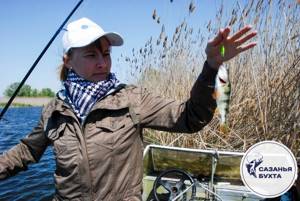
Another feature of autumn fishing is the changeable weather. An excellent bite is ensured on warm sunny days with stable pressure. Fishing in cloudy weather accompanied by precipitation and sharp gusts of wind is unpromising. The situation changes with the arrival of the first cold weather. The fish senses the approach of winter and actively goes in search of food. This is the best time to catch a predator with a worm.
Mormyshka without nozzle and with nozzle
The jig is a classic. Artificial bait, with or without bait. It has a characteristic shape and weight. Colors may vary. The most popular types of jigs among fishing are:
|
- jig “Nymph” (its length is three times greater than its width, due to its light weight it is effective at shallow depths and in standing water);
- jig “Bedbug” (width, as a rule, is slightly less than length or equal to it, in most cases made of red copper);
- flat tungsten jig (suitable for reservoirs with strong currents and serious depth, supplemented with a movable cambric).
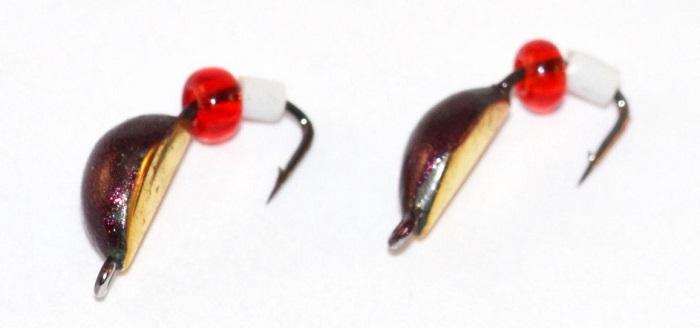
The color of jigs can be different. Their play is much more important. The more ornate the vibrations of the bait, the greater the chances that catching large perch in winter will be successful. To achieve this effect, it is recommended to use jigs without additional attachments, attaching them at a slight angle to the fishing line. If with a bait, the bait should be in a vertical position.
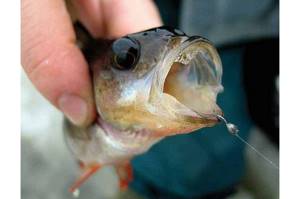
In the form of nozzles, you can use anything that is easy to get, starting with a worm, ending with the jig that clings to the lower surface of the ice in winter. In some cases, catching perch with bloodworms in winter gives good results.
Perch in winter for worms
There is an erroneous stereotype that you can only hunt predators in summer and early autumn. Inexperienced fishermen are wondering: is it possible to catch perch with a worm in winter, or should they wait until it warms up? This is quite real - in winter, the worm often helps out fishermen.
In general, the predator is active all year round and rarely goes into complete hibernation. But a lot depends on weather conditions. In the first weeks of cold weather, the fish live a normal life and attack the worm with appetite. But as the ice cover thickens, the water temperature drops and there is less oxygen. The fish begins to change location in search of food and oxygen supplies. But until severe frosts hit, she is actively looking for food, so you can count on a generous catch.
Catching perch in winter with a worm requires patience. You may have to drill several holes before you find a “fishing spot.” Again, it all depends on weather factors. You can start when the reservoir is covered with ice at least 5 cm thick. But if there is no snow, any movement on the ice can scare away the fish. If you don’t want to wait for snowfall, you can use this trick:
- Drill holes in advance.
- Lay out a raincoat on the surface of the ice.
- Prepare the equipment and install the seat.
- Feed the predator.
During the first ice season, the number of the flock reaches 10-15 individuals. If the bite is successful, you can catch most of the fish. When there are few individuals left, they leave the place to join another flock.
Small perch can be caught using worms in coastal waters in winter. This is relevant in the dead of winter, when oxygen reserves are depleted, the fish loses activity and sinks to depth. But small individuals often spend the winter near the coast, where the oxygen concentration is higher due to thin ice.
By the end of winter, in addition to the lack of oxygen, the food supply will become scarce. With the advent of a thaw, the thickness of the ice decreases, and the fish rise to the surface again in search of oxygen and food. You can use a trick - feed not the perch itself, but its food supply (small fish). And when a hungry predator happily comes to places where there are a lot of fry, you can start fishing with a worm.
Catching perch with a worm is a simple and affordable way to get a generous catch.
Experienced fishermen advise baiting several worms - a moving ball attracts a predator. In addition to live bait, you can use silicone analogues. In appearance they do not differ from living worms. If there is no bite in one place for a long time, it is worth changing the location.
TAGS:
What to use to catch saberfish in winter
Artificial baits:
- For edible rubber. Imitates natural food. Made half from the smells, tastes of crayfish and shrimp. The size is enough 1.2 inches, hook number 12. Placed on the front of the bait.
- Microwisters, flies.
Read! Winter bait for catching roach
Animal origin:
- Maggot. Several larvae are attached to a jig or hook. The plus is that it lasts a long time. One of the best baits.
- Muckworm. Pre-cut into pieces.
- Bloodworm. Best suited for a thin wire hook. She remains attractive the longest.
- Pieces of lard and dough. Used as a last resort.
In winter, fish like to eat high-calorie foods. Large individuals can eat fry, while small ones will be satisfied with a worm on a shiny hook.
Tags
Carp Buffalo Spring Vobla Asp Winter Crucian Rudd Summer Fishing baits Lower Volga Perch Autumn Fisherman's reminder Lures Bite forecast Fishing in Astrakhan Fishing baits Fishing tackle Fishing secrets Catfish Fishing methods Pike perch Catch Pike
Spinner and balancer
Loading …
Fishing with lures in winter and summer has some differences. If in the warm season the spoon is held horizontally, then in cold weather it is carried out vertically. This way, the likelihood of catching some kind of “surprise” hidden under the ice is minimized. Fishing for perch in winter is all about testing holes, so it is important that the lures do not stray too far from their center. The type of bait depends on the nature of the reservoir. If it is deep, then the spoon should be heavy, if it is shallow, it should be less massive. It is allowed to use either one or several hooks. They can be fixed or suspended. A couple of cambrics wouldn't hurt either. Sometimes catching perch in winter with a cone and catching perch in winter with a self-shaking rod are effective - both homemade and purchased.
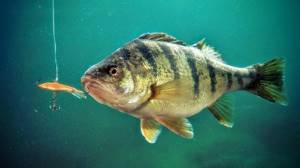
The balancer is a different story. Visually, it resembles a small fish and, thanks to its shape, can either maneuver or stand statically at a certain depth. The bait fully lives up to its name, since it is in a horizontal position in the water, as if balancing. As a rule, one hook, or more often a tee, is attached to the tummy of an artificial fish. In itself, such a bait is interesting to perch, but it becomes even more attractive when the fisherman skillfully manipulates it, i.e. moves.
Where to look for perch in winter
Perch is a social fish, so they always stay in schools of 20 or more individuals. They love everything shiny and that looks like food, and they compete with each other who can bite it first, so if you manage to find a school of perch in a pond, then a catch is guaranteed. In winter, the best time to catch large perch is the end of December and the beginning of March, at which time they are most active.
Tip 1: Drill a hole next to another angler
The advice may not be very good, but it is effective; if you see one angler pulling out one perch after another, you can safely sit not far from him and catch perch from the same school.
Tip 2: Don't use one hole
Unlike pike perch, perch does not lead a secretive lifestyle; it will not lie on the bottom, but will constantly move along it, staying a few centimeters from the ground. Therefore it is necessary to look for it. Drill 10-15 holes at places where depths change, from the shore to the center of the reservoir and constantly move between them until you find a school, then fish on it until it leaves.
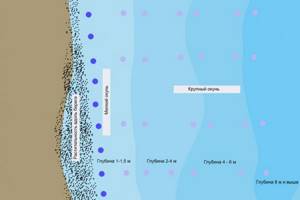
Depending on the type of reservoir, perch have different behavior.
On lakes where there are no such shelters at the bottom as stone reefs, boulders, logs, etc., large perch will be at great depths, there is no point in catching them along the coastal vegetation, only if you do not want to catch small things, they can stand next to shore.
In such reservoirs, large perch, as a rule, are mobile and actively move around the reservoir, so you will have to run after it. Drill more holes and use a fish finder and move around until you find the school.
The average depth for searching for large perch is from 7 to 12 meters. The best places are depth differences.
Small perch in such reservoirs can easily be found near the shore at depths of 1.5 meters.
We recommend: Catchy wobblers for perch
Perch prefers a hard bottom, at the bottom of which you can find various crustaceans, mollusks and other food.
In reservoirs where there are natural shelters at the bottom, large perch can also stay near the shore.
Catching large roach with a worm
If small roach are not of interest, then you should stock up on worms. As a rule, only large roaches are caught with this bait. Note that in addition to roach, bream, perch, burbot and pike perch can bite on the worm in winter, so the tackle for such fishing must be strong.
For fishing in areas of the reservoir where the depth is more than three meters, it is recommended to use medium-sized jigs, on which a small worm is attached as bait. Note that it is with a worm in winter, especially at the end of winter, that you can catch large roaches.
